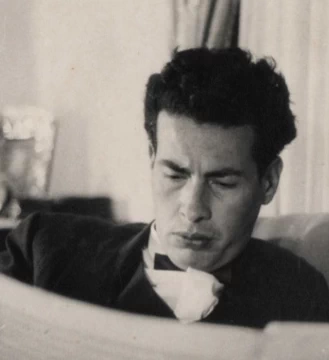A pioneer among the musicians of his generation, Navarre is one of the most influential Bolivian composers of his time. Born in La Paz in 1931, he began his formal musical education at an early age, and in 1947 he became a student of Egon-Carl Schif. The following year, he entered the Conservatorio Plurinacional de Música (COPLUMU) [Plurinational Conservatory of Music] in La Paz to continue his piano studies under the tutelage of Alicia Eguino de Justiniano and Mario Estensoro. While at the conservatory, he studied music theory with Teófilo Molina and harmony and counterpoint with Erich Eisner. Nine years after entering the conservatory, he was appointed professor in 1957 and began to teach harmony, counterpoint, and composition as a professor at the conservatory. In 1968, he participated in a competition in Geneva, Switzerland, where he was awarded a scholarship to study music at the Ecole Normale de Musique in Paris, France. During this period, he studied orchestration, composition, and musical analysis with world-renowned composers such as Henri Dutilleux (1916-2013) and Marcel Mihalovici (1898-1985). After returning to Bolivia, Navarre became the Director of the COPLUMU in 1970. Navarre has received many recognitions, including several national awards, including the Ministry of Education Award and the prestigious Luz Mila Patiño Award. Navarre died in La Paz in 2006. Navarre was a prolific composer. Unfortunately, most of his work was lost in a fire in the 1990s. Items lost include original, plain copies, manuscripts, and a catalog of his works. His prolific production is known only through his colleagues, fellow musicians, family, and friends. Fellow composer Atiliano Auza describes his composition style as neo-romantic but with a local influence. Musicologists Suzanne Spicer Tiemstra and Gerard Béhague describe his style as combining neo-romanticism with Bolivian elements and nationalism. The musicologist Leslie Bethell affirms that Navarre had "created a neo-romantic language sometimes combined with features of Bolivian folk music.” Navarre's work included written vocal works, sonatas, piano trios, string quartets, piano quintets, and larger orchestral compositions, including at least two symphonies. The news of this loss devastated the Navarre family and Bolivia's musical heritage. However, to the surprise of many, some of Navarre's compositions have emerged recently. Photocopies of a Sonata for violin and piano, a string quartet, a short Elegy for violin and piano, and a symphony in two movements have been found in private collections and the library of the National Symphony Orchestra in La Paz. In June 2012, during a concert trip to Bolivia, researcher Javier Pinell and co-researcher Sergio Ruiz became aware of these results and the idea of compiling these manuscripts, their study, public presentation, and recording.

